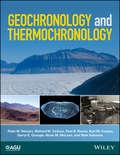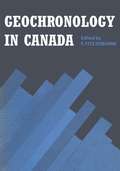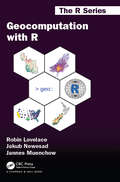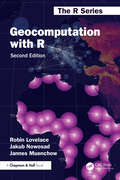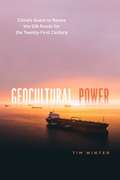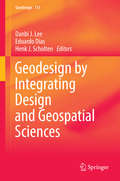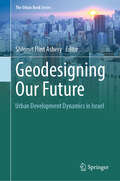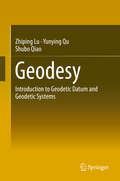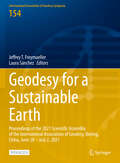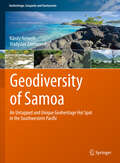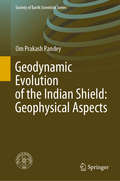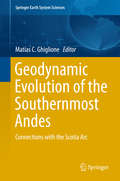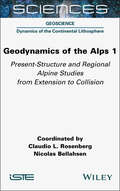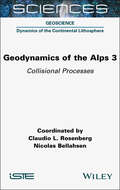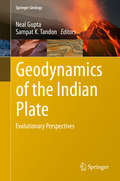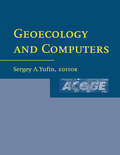- Table View
- List View
Geochronology and Thermochronology (Wiley Works)
by Peter W. Reiners Richard W. Carlson Paul R. Renne Kari M. Cooper Darryl E. Granger Noah M. McLean Blair SchoeneThis book is a welcome introduction and reference for users and innovators in geochronology. It provides modern perspectives on the current state-of-the art in most of the principal areas of geochronology and thermochronology, while recognizing that they are changing at a fast pace. It emphasizes fundamentals and systematics, historical perspective, analytical methods, data interpretation, and some applications chosen from the literature. This book complements existing coverage by expanding on those parts of isotope geochemistry that are concerned with dates and rates and insights into Earth and planetary science that come from temporal perspectives. Geochronology and Thermochronology offers chapters covering: Foundations of Radioisotopic Dating; Analytical Methods; Interpretational Approaches: Making Sense of Data; Diffusion and Thermochronologic Interpretations; Rb-Sr, Sm-Nd, Lu-Hf; Re-Os and Pt-Os; U-Th-Pb Geochronology and Thermochronology; The K-Ar and 40Ar/39Ar Systems; Radiation-damage Methods of Geo- and Thermochronology; The (U-Th)/He System; Uranium-series Geochronology; Cosmogenic Nuclides; and Extinct Radionuclide Chronology. Offers a foundation for understanding each of the methods and for illuminating directions that will be important in the near future Presents the fundamentals, perspectives, and opportunities in modern geochronology in a way that inspires further innovation, creative technique development, and applications Provides references to rapidly evolving topics that will enable readers to pursue future developments Geochronology and Thermochronology is designed for graduate and upper-level undergraduate students with a solid background in mathematics, geochemistry, and geology.Read an interview with the editors to find out more:https://eos.org/editors-vox/the-science-of-dates-and-rates
Geochronology in Canada (The Royal Society of Canada Special Publications #No. 8)
by Freleigh OsborneThis volume is made up of papers presented at a colloquium of the Geology Devision of Section III of the Royal Society of Canada at the annual meeting in Quebec, June 1963. The papers fall into two groups: in one group the validity and shortcomings of the methods of establishing the geographical time-table are discussed; and, in the other, applications of the methods to areas across Canada, and from Precambrian to recent, are described. The geological time-table has been built up from the record of the rocks and is based on the law of superposition, a fact that is pointed out in the first paper of this volume. The chronological value of fossils, palaeomagnetism as a means of dating geological events, the limitations of radiometric dating, and other pertinent matters are here dealth with by a group of well-known authorities. These scientific disquisitions will be of great importance to geologists everywhere.This work should be of special interest to those engaged in research on the history of the earth, particularly in relation to the nature, the causes, and the time of an event. It will also serve as a valuable reference to practising geologists in government or industry, to university departments of geology, and to geological consultants. Royal Society of Canada, "Special Publications" Series, no. 8.
Geocomputation with R (Chapman & Hall/CRC The R Series)
by Robin Lovelace Jakub Nowosad Jannes MuenchowGeocomputation with R is for people who want to analyze, visualize and model geographic data with open source software. It is based on R, a statistical programming language that has powerful data processing, visualization, and geospatial capabilities. The book equips you with the knowledge and skills to tackle a wide range of issues manifested in geographic data, including those with scientific, societal, and environmental implications. This book will interest people from many backgrounds, especially Geographic Information Systems (GIS) users interested in applying their domain-specific knowledge in a powerful open source language for data science, and R users interested in extending their skills to handle spatial data. The book is divided into three parts: (I) Foundations, aimed at getting you up-to-speed with geographic data in R, (II) extensions, which covers advanced techniques, and (III) applications to real-world problems. The chapters cover progressively more advanced topics, with early chapters providing strong foundations on which the later chapters build. Part I describes the nature of spatial datasets in R and methods for manipulating them. It also covers geographic data import/export and transforming coordinate reference systems. Part II represents methods that build on these foundations. It covers advanced map making (including web mapping), "bridges" to GIS, sharing reproducible code, and how to do cross-validation in the presence of spatial autocorrelation. Part III applies the knowledge gained to tackle real-world problems, including representing and modeling transport systems, finding optimal locations for stores or services, and ecological modeling. Exercises at the end of each chapter give you the skills needed to tackle a range of geospatial problems. Solutions for each chapter and supplementary materials providing extended examples are available at https://geocompr.github.io/geocompkg/articles/.
Geocomputation with R (Chapman & Hall/CRC The R Series)
by Robin Lovelace Jakub Nowosad Jannes MuenchowGeocomputation with R is for people who want to analyze, visualize, and model geographic data with open source software. The book provides a foundation for learning how to solve a wide range of geographic data analysis problems in a reproducible, and therefore scientifically sound and scalable way. The second edition features numerous updates, including the adoption of the high-performance terra package for all raster data processing, detailed coverage of the spherical geometry engine s2, updated information on coordinate reference systems and new content on openEO, STAC, COG, and gdalcubes. The data visualization chapter has been revamped around version 4 of the tmap package, providing a fresh perspective on creating publication-quality maps from the command line. The importance of the book is also highlighted in a new foreword by Edzer Pebesma.The book equips you with the knowledge and skills necessary to tackle a wide range of issues manifested in geographic data, including those with scientific, societal, and environmental implications. The book is especially well-suited to: Data scientists and engineers interested in upskilling to handle spatial data. People with existing geographic data skills interested in developing powerful geosolutions via code. Anyone who needs to work with spatial data in a reproducible and scalable way. The book is divided into three parts: Foundations, Extensions, and Applications, covering progressively more advanced topics. The exercises at the end of each chapter provide the necessary skills to address various geospatial problems, with solutions and supplementary materials available at r.geocompx.org/solutions/.
Geoconservation and Geotourism Potential of India (Society of Earth Scientists Series)
by Satish C. Tripathi Naresh Chandra Pant Sameeta RajoraIndia is blessed with great geological diversity as it has recorded more than 3.5 billion year’s history of evolution of Earth, some of the sites/sections are unique to the globe. The recent discovery of youngest ‘Meghalayan age’ from a limestone cave of Meghalaya is internationally recognised. The Indian rock record bears the signatures of various global geological events including evolution of life, mass extinction, making of Himalaya, meteoritic impact craters etc. Indian dinosaur 'Rajasaurus' created curiosity in the children. Interestingly, large number of geoheritage sites are associated with well-known cultural heritage sites and biodiversity hotspots. However, proper scientific details of geoheritage sites and their potential to develop as a geotourism hotspot has not been discussed. Geotourism potential of India in extensive but so far it has not attracted attention of authorities and agencies of the Tourism sector. The present book provides a platform for them to plan and explore. Development of geotourism will lead to conservation of geoheritage sites and both financial and scientific aspects will be covered.
Geocryology: Characteristics and Use of Frozen Ground and Permafrost Landforms
by Stuart A. Harris Anatoli Brouchkov Cheng GuodongThis book provides a general survey of Geocryology, which is the study of frozen ground called permafrost. Frozen ground is the product of cold climates as well as a variety of environmental factors. Its major characteristic is the accumulation of large quantities of ice which may exceed 90% by volume. Soil water changing to ice results in ground heaving, while thawing of this ice produces ground subsidence often accompanied by soil flowage. Permafrost is very susceptible to changes in weather and climate as well as to changes in the microenvironment. Cold weather produces contraction of the ground, resulting in cracking of the soil as well as breakup of concrete, rock, etc. Thus permafrost regions have unique landforms and processes not found in warmer lands. The book is divided into three parts. Part 1 provides an introduction to the characteristics of permafrost. Four chapters deal with its definition and characteristics, the unique processes operating there, the factors affecting it, and its general distribution. Part 2 consists of seven chapters describing the characteristic landforms unique to these areas and the processes involved in their formation. Part 3 discusses the special problems encountered by engineers in construction projects including settlements, roads and railways, the oil and gas industry, mining, and the agricultural and forest industries. The three authors represent three countries and three language groups, and together have over 120 years of experience of working in permafrost areas throughout the world. The book contains over 300 illustrations and photographs, and includes an extensive bibliography in order to introduce the interested reader to the large current literature. Finalist of the 2019 PROSE Awards.
Geocultural Power: China's Quest to Revive the Silk Roads for the Twenty-First Century (Silk Roads)
by Tim WinterLaunched in 2013, China's Belt and Road Initiative is forging connections in infrastructure, trade, energy, finance, tourism, and culture across Eurasia and Africa. This extraordinarily ambitious strategy places China at the center of a geography of overland and maritime connectivity stretching across more than sixty countries and incorporating almost two-thirds of the world’s population. But what does it mean to revive the Silk Roads for the twenty-first century? Geocultural Power explores this question by considering how China is couching its strategy for building trade, foreign relations, and energy and political security in an evocative topography of history. Until now Belt and Road has been discussed as a geopolitical and geoeconomic project. This book introduces geocultural power to the analysis of international affairs. Tim Winter highlights how many countries—including Iran, Sri Lanka, Kenya, Malaysia, Indonesia, Pakistan, and others—are revisiting their histories to find points of diplomatic and cultural connection. Through the revived Silk Roads, China becomes the new author of Eurasian history and the architect of the bridge between East and West. In a diplomatic dance of forgetting, episodes of violence, invasion, and bloodshed are left behind for a language of history and heritage that crosses borders in ways that further the trade ambitions of an increasingly networked China-driven economy.
Geodesign by Integrating Design and Geospatial Sciences
by Henk J. Scholten Danbi J. Lee Eduardo DiasIn Europe, the emerging discipline of geodesign was earmarked by the first Geodesign Summit held in 2013 at the GeoFort, the Netherlands. Here researchers and practitioners from 28 different countries gathered to exchange ideas on how to merge the spatial sciences and design worlds This book brings together experiences from this international group of spatial planners, architects, landscape designers, archaeologists, and geospatial scientists to explore the notion of 'Geodesign thinking', whereby spatial technologies (such as integrated 3D modelling, network analysis, visualization tools, and information dashboards) are used to answer 'what if' questions to design alternatives on aspects like urban visibility, flood risks, sustainability, economic development, heritage appreciation and public engagement The book offers a single source of geodesign theory from a European perspective by first introducing the geodesign framework, then exploring various case studies on solving complex, dynamic, and multi-stakeholder design challenges This book will appeal to practitioners and researchers alike who are eager to bring design analysis, intelligent planning, and consensus building to a whole new level
Geodesigning Our Future: Urban Development Dynamics in Israel (The Urban Book Series)
by Shlomit Flint AsheryThis book examines how map-based collaboration software can facilitate negotiations in areas undergoing contentious pressures for significant change. Based on case studies from Israel, it aims to introduce a useful model of planning implementation as an outcome of complex interaction to reduce the gap between planning and urban reality. It puts an analytical realist foundation for a productive discussion of the role of future planning and bares meaningful scientific contributions to the general frame of the negotiating process and implementation, which still needs further research and elaboration.Geodesign, a cutting-edge planning approach that is rooted in the history of planning practice, has become one of the most popular approaches for sustainable planning and design activities after 2000s. Planners tend to think of design at a site scale, but geodesign covers a variety of scales, bridging the gap between the regional and the local contexts.This is important because to be practically effective and politically prudent, "smart growth" plans need to make sense across a spectrum of scales and disciplines. This ranges from design, urban design, community planning, town and city planning, and regional planning, up to planning for mega-regions.
Geodesy
by Zhiping Lu Yunying Qu Shubo QiaoGeodetic datum (including coordinate datum, height datum, depth datum, gravimetry datum) and geodetic systems (including geodetic coordinate system, plane coordinate system, height system, gravimetry system) are the common foundations for every aspect of geomatics. This course book focuses on geodetic datum and geodetic systems, and describes the basic theories, techniques, methods of geodesy. The main themes include: the various techniques of geodetic data acquisition, geodetic datum and geodetic control networks, geoid and height systems, reference ellipsoid and geodetic coordinate systems, Gaussian projection and Gaussian plan coordinates and the establishment of geodetic coordinate systems. The framework of this book is based on several decades of lecture noted and the contents are developed systematically for a complete introduction to the geodetic foundations of geomatics.
Geodesy for Planet Earth
by Urs Marti Maria Christina Pacino Steve KenyonThese proceedings include the written version of 130 papers presented at the International Association of Geodesy IAG2009 "Geodesy for Planet Earth" Scientific Assembly. It was held 31 August to 4 September 2009 in Buenos Aires, Argentina. The theme "Geodesy for Planet Earth" was selected to follow the International Year of Planet Earth 2007-2009 goals of utilizing the knowledge of the world's geoscientists to improve society for current and future generations. The International Year started in January 2007 and ran thru 2009 which coincided with the IAG2009 Scientific Assembly, one of the largest and most significant meetings of the Geodesy community held every 4 years. The IAG2009 Scientific Assembly was organized into eight Sessions. Four of the Sessions of IAG2009 were based on the IAG Structure (i.e. one per Commission) and covered Reference Frames, Gravity Field, Earth Rotation and Geodynamics, and Positioning and Applications. Since IAG2009 was taking place in the great Argentine city of Buenos Aires, a Session was devoted to the Geodesy of Latin America. A Session dedicated to the IAG's Global Geodetic Observing System (GGOS), the primary observing system focused on the multidisciplinary research being done in Geodesy that contributes to important societal issues such as monitoring global climate change and the environment. A Session on the IAG Services was also part of the Assembly detailing the important role they play in providing geodetic data, products, and analysis to the scientific community. A final Session devoted to the organizations ION, FIG, and ISPRS and their significant work in navigation and earth observation that complements the IAG.
Geodesy for a Sustainable Earth: Proceedings of the 2021 Scientific Assembly of the International Association of Geodesy, Beijing, China, June 28 – July 2, 2021 (International Association of Geodesy Symposia #154)
by Jeffrey T. Freymueller Laura SánchezThis open access volume contains selected papers of the 2021 Scientific Assembly of the International Association of Geodesy – IAG2021. The Assembly was hosted by the Chinese Society for Geodesy, Photogrammetry and Cartography (CSGPC) in Beijing, China from June 28 to July 2, 2021. It was a hybrid conference with in-person and online attendants. In total, the Assembly was attended by 146 in-person participants and 1,123 online participants. The theme of the Assembly was Geodesy for a Sustainable Earth. 613 contributions (255 oral presentations and 358 poster presentations) covered all topics of the broad spectrum considered by the IAG: geodetic reference frames, Earth gravity field modelling, Earth rotation and geodynamics, positioning and applications, the Global Geodetic Observing System (GGOS), geodesy for climate research, marine geodesy, and novel sensors and quantum technology for geodesy. All published papers were peer-reviewed, and we warmly recognize the contributions and support of the Associate Editors and Reviewers.
Geodetic Boundary Value Problem: the Equivalence between Molodensky’s and Helmert’s Solutions
by Fernando Sansò Michael G. SiderisThis book offers a new approach to interpreting the geodetic boundary value problem, successfully obtaining the solutions of the Molodensky and Stokes boundary value problems (BVPs) with the help of downward continuation (DC) based methods. Although DC is known to be an improperly posed operation, classical methods seem to provide numerically sensible results, and therefore it can be concluded that such classical methods must in fact be manifestations of different, mathematically sound approaches. Here, the authors first prove the equivalence of Molodensky's and Stoke's approaches with Helmert's reduction in terms of both BVP formulation and BVP solutions by means of the DC method. They then go on to show that this is not merely a downward continuation operation, and provide more rigorous interpretations of the DC approach as a change of boundary approach and as a pseudo BVP solution approach.
Geodetic Time Series Analysis in Earth Sciences (Springer Geophysics)
by Jean-Philippe Montillet Machiel S. BosThis book provides an essential appraisal of the recent advances in technologies, mathematical models and computational software used by those working with geodetic data. It explains the latest methods in processing and analyzing geodetic time series data from various space missions (i.e. GNSS, GRACE) and other technologies (i.e. tide gauges), using the most recent mathematical models. The book provides practical examples of how to apply these models to estimate seal level rise as well as rapid and evolving land motion changes due to gravity (ice sheet loss) and earthquakes respectively. It also provides a necessary overview of geodetic software and where to obtain them.
Geodiversity of Samoa: An Untapped and Unique Geoheritage Hot Spot in the Southwestern Pacific (Geoheritage, Geoparks and Geotourism)
by Károly Németh Vladyslav ZakharovskyiThis book represents a pioneering effort, offering a comprehensive summary of the Geoheritage of the Southwestern Pacific (SW Pacific). Despite its globally significant Geoheritage , the region has not yet been addressed in its entirety within a cohesive geocultural context, either in book form or through similar media. The SW Pacific is still emerging as a focal point of Geoheritage research, and exploration of the vast geodiversity of this region has only recently begun. While some initial scientific reports exist for specific areas within the SW Pacific, there has been no comprehensive summary covering the entire region. Although the region is primarily renowned for its picturesque beaches and tranquil coastal landscapes, its rich Geocultural aspects remain largely underutilized and understudied. It aims to fill this gap by providing a holistic exploration of the geodiversity and geoheritage of the Samoa islands. By offering an evidence-based and scientifically valid overview of the islands' geoheritage and geodiversity, the book seeks to serve as a foundational resource for future developments in the tourism sector and to define research directions and methodologies for expanding our understanding of volcanic oceanic islands' geoheritage. It will focus on geodiversity and geoheritage within the context of volcanic oceanic islands, which are unique in terms of their geological formations (such as volcanoes and lava fields) and their limited spatial extent within the vast Pacific Ocean basin. This book will also highlight the special coastal regions of volcanic oceanic islands, which often feature fringed reefs and broad shallow marine environments housing unique and fragile ecosystems sensitive to global and planetary changes. By estimating geodiversity, the book will provide insight into how volcanic islands' geoheritage intersects with biodiversity. Geodiversity will be explored as the backdrop for the evolution of tropical marine and mountainous biodiversity in spatially limited areas under tropical conditions. Moreover, this book aims to be a pioneering contribution, offering a methodological manual for exploring other islands from a geodiversity perspective. Currently, there is no similar publication on the market, making this book one of the first of its kind. The authors have conducted extensive research in Samoa, resulting in numerous high-level scientific publications and a wealth of information to be included in this book.
Geodynamic Evolution of the Indian Shield: Geophysical Aspects (Society of Earth Scientists Series)
by Om Prakash PandeyThis book addresses time-bound geotectonic evolution of the various geological terrains of the Indian continent, on the basis of integrated geophysical studies, like seismic, seismological, gravity, magnetic, magnetotelluric and heat flow, carried out over the past five decades. Further, it discusses elastic and petrophysical properties of the Earth’s crust relevant to geological investigations. The book also shares latest findings on the geodynamic development of the Indian shield and nearby continental margins, including Arabian Sea.
Geodynamic Evolution of the Southernmost Andes
by Matías C. GhiglioneThis book focuses on the strong relation between the tectonic evolution of the Southernmost Andes and their closest southern neighbors, the Scotia Sea and Antarctica. Some episodes are related to processes of global significance such as the opening of the Drake Passage, which is somehow linked to Late Cenozoic cooling. Many of the topics covered in the book are subjects of heated debates; as such, not only the latest data and approaches are presented, but different points of view as well. The chapters examine the interrelation between main geodynamic processes and plate tectonics from a multidisciplinary perspective. This Paleozoic-Cenozoic geodynamic evolution of the Southernmost Andes involved interrelated metamorphic, magmatic, sedimentary, and deformational processes directed by plate tectonics. The main topics cover the evolution of the Rocas Verdes basin and the Cordillera Darwin high-grade metamorphic complex, growth of the Patagonian Batholith, development of the Patagonian Orocline, the opening of the Drake Passage during growth of the Scotia Sea, evolution of the Austral-Magallanes foreland basin and its related fold and thrust belt.
Geodynamics
by Donald L. Turcotte Gerald SchubertFirst published in 1982, Don Turcotte and Jerry Schubert's Geodynamics became a classic textbook for several generations of students of geophysics and geology. In this second edition, the authors bring this text completely up-to-date. Important additions include a chapter on chemical geodynamics, an updated coverage of comparative planetology based on recent planetary missions, and a variety of other new topics. Geodynamics provides the fundamentals necessary for an understanding of the workings of the solid earth, describing the mechanics of earthquakes, volcanic eruptions, and mountain building in the context of the role of mantle convection and plate tectonics. Observations such as the earth's gravity field, surface heat flow, distribution of earthquakes, surface stresses and strains, and distribution of elements are discussed. This new edition will once again prove to be a classic textbook for intermediate to advanced undergraduates and graduate students in geology, geophysics, and earth science.
Geodynamics of the Alps 1: Present-Structure and Regional Alpine Studies from Extension to Collision
by Claudio L. Rosenberg Nicolas BellahsenGeodynamics of the Alps consists of three volumes. This first volume describes the recent and present-day structure and tectonic setting of the Alpine chain, from the lithospheric mantle to brittle crust and surface topography. It also provides a historical overview of Alpine research, with two chapters covering specific Alpine regions (Corsica and the Eastern Alps) through all phases of Alpine history. The aim of this book is to create a space for experts on Alpine research to present the state of the art of specific subjects and provide their own interpretations.
Geodynamics of the Alps 2: Pre-collisional Processes
by Claudio L. Rosenberg Nicolas BellahsenGeodynamics of the Alps consists of three volumes. This second volume presents the pre-collisional history of the Alps. It discusses the Variscan orogeny in the Alpine realm, the inferred paleo-geography, the structure and processes affecting continental margins and the mantle structure in the pre-orogenic Alpine realm. It concludes by describing oceanic and continental subduction processes. The aim of this book is to create a space for experts on Alpine research to present the state of the art of specific subjects and provide their own interpretations.
Geodynamics of the Alps 3: Collisional Processes
by Claudio L. Rosenberg Nicolas BellahsenGeodynamics of the Alps consists of three volumes. This third volume is entirely dedicated to Alpine collision. It describes and interprets elements of the Alpine chain, including Alpine magmatism, the formation of external massifs, the foreland basin, the exhumation of the internal part of the chain and the northern deformation front of the Alps. The aim of this book is to create a space for experts on Alpine research to present the state of the art of specific subjects and provide their own interpretations.
Geodynamics of the Indian Plate: Evolutionary Perspectives (Springer Geology)
by Neal Gupta Sampat K. TandonThis book provides insights on new geological, tectonic, and climatic developments in India through a time progression from the Archean to the Anthropocene that are captured via authoritative entries from experts in earth sciences. This volume aims to bring graduate students and researchers up to date on the geodynamic evolution of the Indian Plate; concepts that have so far resulted in a rather uneven treatment of the subject at different institutions.The book is divided into 4 sections and includes perspectives such as the formation and evolution of the Indian crust in comparison to its neighbors such as Antarctica, Africa and Australia; the evolution of Precambrian cratons and sedimentary basins of India; and a summary account of early life reported in the Indian stratigraphic record. Readers will also discover the key recent research into the neotectonics, tectonic geomorphology, and paleoseismology of the Himalayan Front. Researchers and students in geology, earth sciences, sedimentology, paleobiology and geography will find this book appealing.
Geoecology and Computers
by Sergey A. YufinThis volume presents technical papers devoted to development and practical use of computer methods in geotechnical and geoenviromental engineering. It covers issues on space use and construction, soil and rock mechanics, and mining applications amongst other topics.
Geoecology of Landscape Dynamics (Advances in Geographical and Environmental Sciences)
by R. B. Singh Manish Kumar Seema SahdevThis book provides an overview of the ecological indicators of landscape dynamics in the context of geographical landscape integration. Landscape dynamics depicts every change that occurs in the physical, biological, and cognitive assets of a landscape. To understand and interpret the complex physical, biological, and cognitive phenomena of landscapes, it is necessary to operate conceptually and practically on a broad range of spatial and temporal scales. Rapid land use changes have become a concern to environmentalists and planners because of their impacts on the natural ecosystem, which further determines socioeconomic dynamics. In this regard, the book discusses case studies that share new insights into how landscape patterns and processes impact small creatures, and how small creatures in turn influence landscape structure and composition. In turn, the relevant aspects of land use and land cover dynamics are covered, and the multi-faceted relationship between the substrata and ecological community is highlighted. The book is unique in its focus on the application of spatial informatics such as automatic building extraction from high-resolution imagery; a soil resource inventory for meeting the challenges of land degradation; hydrological modeling; the temporal variation analysis of glacier area and the identification and mapping of glacial lakes; morphometric analysis of river basins; and the monitoring and modeling of urban sprawl, among other features.
Geoecology: An Evolutionary Approach
by Richard HuggettAnimals, plants and soils interact with one another, with the terrestrial spheres, and with the rest of the Cosmos. On land, this rich interaction creates landscape systems or geoecosystems. Geoecology investigates the structure and function of geoecosystems, their components and their environment. The author develops a simple dynamic systems model, the `brash' equation, to form the conceptual framework for the book suggesting an `ecological' and `evolutionary' approach. Exploring internal of `ecological' interactions between geoecosystems and their near-surface environments - the atmosphere, hydrosphere, toposhere, and lithosphere - and external influences, both geological and cosmic, Geoecology presents geoecosystems as dynamic entities constantly responding to changes within themselves and their surroundings. An `evolutionary' view emerges of geoecological systems, and the animals, plants, and soils comprising them, providing a new way of thinking for the whole environmental complex and the rich web of interdependencies contained therein.
